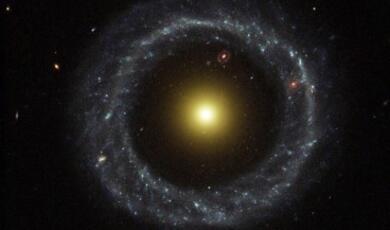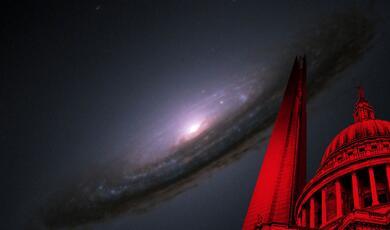How It Ends: What We Know about the Fate of the Universe
Share
- Details
- Text
- Audio
- Downloads
- Extra Reading
How will it all end? Predicting the far future of our Universe depends on understanding its present. This lecture starts with what seems to be a paradox in modern cosmology: that we have a model that does a fantastic job of explaining what we see, but which says 95% of the Universe is in forms (dark matter and dark energy) that we don’t understand. From there, we get a quick tour of the next 100 billion years – and speculate how the Universe’s end may hold the secrets of its beginnings.
Featuring musician Steve Pretty.
Download Text
How It Ends: What we know about the fate of the Universe
The State of our Universe, Lecture 1
Prof. Chris Lintott
24 September 2025
As astronomers have looked into the distant future, attempting to understand the fate of the cosmos, they’ve learned that the news doesn’t look good. Our Sun, for example, an ordinary middle aged star, is a little more than four billion years into a lifetime of burning hydrogen in its core that might last another four billion years. As it exhausts the fuel at its core, it will swell into a red giant, engulfing the Earth[1]. If that worries you, there is worse news to come. As hydrogen is converted into helium, the efficiency with which the nuclear furnace at our star’s centre can create radiation decreases, and so the core contracts, and thus heats up. This creates an inexorable rise in the Sun’s luminosity, and the Earth will be too warm to sustain an atmosphere in the small matter of a billion years or so[2].
While it is tempting to argue that the certainty of catastrophe on these timescales puts everyday problems in their proper perspective, the bleakness of the long-term outlook may explain why understanding the future of the Universe – the science of cosmic eschatology – has received relatively little attention. Steven Weinberg, writing in his magisterial ‘First Few Minutes’ which remains a wonderful introduction to the early Universe, comments when contemplating the future that ‘The more the Universe seems comprehensible, the more it seems pointless’. The endlessly creative Freeman Dyson in his (comparatively cheerful) study of speculative physics and biology notes that work in the field seems to be written up in an ‘apologetic or jocular’ style, rather than being treated as serious science, but contemplating the end of the Universe can help us understand it as well as giving us some cosmic perspective.
We must make one fundamental assumption – that the laws of physics we experience today, and which we can explore, hold for the rest of eternity. If things change dramatically, then our ability to predict what will happen is lost. Some reassurance that this isn’t happening comes from studies like that of the Okio uranium mine, where we observe the product of a natural fission reactor that operated billions of years ago, and can compare them to what we see today. Observing the spectra of quasars in the early Universe can also provide a test of varying fundamental constants. Given that there is no convincing evidence of a change in fundamental constants, and so we can proceed.
Understanding the end of the Universe starts with thinking about its beginnings. Edwin Hubble’s discovery, using Cepheid variable stars as standard candles (objects whose luminosity can be inferred from their behaviour, and hence their distance calculated), that the Universe was expanding gave rise to the idea that it began in a hot, dense state which we call the Big Bang. The behaviour of such a cosmos can be described in general relativity by a mathematical formulism called the Freidmann-Lemaître-Robertson-Walker metric[3], which describes how an isotropic, homogeneous Universe expands and contracts under the influence of what it contains[4]. It was quickly realised that the crucial factor was the density of matter in the Universe: if the density of matter was below some critical value, the Universe could expand for ever. At the critical value, gravity would slow the expansion, but not stop it. And if the density of matter exceeds the critical value, then gravity would eventually triumph over the expansion and the Universe would eventually collapse in on itself.
This latter possibility – usually known as a Big Crunch[5] - has some attractive features. If some unknown physical processes could halt and reverse the collapse, then one can invoke an endless succession of bouncing universes, which amongst other things allows a convenient escape from having to explain the Big Bang, which becomes just one rebound amongst many. It must be said, though, that if this cheers cosmologists the news for those of us stuck inside the collapsing cosmos is less good. In what he later described as a ‘cheerful’ paper, Martin Rees explained the ‘catastrophic process whereby the contracting cosmos reverts to primaeval chaos’.
As the contraction starts, very little would obviously change in the Universe. Redshifts would become blueshifts, as the distance between clusters of galaxies decreases, but it would take a long time for clusters to merge together. Eventually, though – Rees estimates when the Universe has contracted by a factor of five from its maximum size – clusters will merge together. After a further compression of a factor of ten, galaxies too will merge, and the Universe will be a sea of stars[6].
Any planets remaining around those stars will be fine, until, as the contraction continues, the background radiation heats up. Eventually this will create a bath of energy the same temperature as the surface of the stars themselves, which will no longer be able to lose energy. I’m not sure anyone has done detailed calculations of what will happen next, but in any case the Universe will soon reach a temperature where nuclear reactions, normally confined to the core of a star, ignite spontaneously throughout and the last great firework display takes place. Just before the final Crunch, the Universe is a sea of particles and radiation at incredibly high temperatures.
This may seem like we have returned to the Big Bang, but there is a crucial difference. The second law of thermodynamics tells us that systems always move towards states of higher entropy, or disorder, and so our Universe must have started in a state of low entropy. A Big Crunch, however, is a disordered soup of particles and radiation, a near maximally entropic state, and without invoking new, magical physics to reset things, breaking the law of thermodynamics as we move from one Universe to the next, the rebounding Universe will produce only high entropy universes, useless for the creation of large-scale structure or, indeed, for life[7]. (There are more modern, exotic cosmologies that seek to avoid this trap, which I will not consider here).
So is a cosmic collapse inevitable? In the second half of the 20th century, astronomers using the enormous new telescope at Palomar, with its 200” (~5m) mirror amongst others, plus increasingly powerful radio telescopes, sought to measure the Universe’s deceleration and hence determine the density of matter within it. The hope was that some feature of the local Universe – say, the size of the brightest galaxy in a cluster, or the infrared brightness of radio galaxies – might turn out to be the same everywhere, allowing distances to be measured.
Unfortunately, more was learned about the evolution of galaxies and clusters throughout cosmic history than about the expansion rate of the Universe. There are very few features of the Universe which haven’t changed over time, and it wasn’t until features of the cosmic microwave background (the topic of a lecture last year: https://www.gresham.ac.uk/watch-now/first-light) were measured in detail in the late 1990s that convincing measurements were obtained. The result was consistent with what measurements of the mass of typical galaxies and clusters had suggested: there is nowhere near enough matter in the Universe to reverse the expansion. Our fate is very different from a Big Crunch.
In a ever-expanding, or ‘open’ Universe, there is time for everything to happen. Within galaxies like the Milky Way, star formation will continue for now, but eventually the supply of gas, the required raw material, will be exhausted. Already, the rate of star formation in the Universe is lower than at its peak approximately ten billion years ago, and it is likely that more stars now die each year than are being born. Lower mass stars survive longer than their more massive counterparts, which exhaust their reserves of fuel faster, and so the final parts of what Adams & Laughlin (1996) call the Stelliferous Era of the Universe will be lit by faint, red dwarfs.
Understanding the exact timing of this dimly lit future still requires understanding the ingredients of which the Universe is made, and in the 1990s two teams of astronomers set out to make use of a particular type of supernova to measure the deceleration. Type Ia supernovae, which form when material from a giant star builds up on the surface of a white dwarf companion and ignites, are good standard candles[8] and bright enough to be seen at great distances. Both teams, to their surprise, found that the Universe was not decelerating at all, but accelerating.
This astonishing result has since been confirmed by other results; the cause of the acceleration is usually attributed to an as-yet-not-understood force known as ‘dark energy’. The new concordance cosmology – often known as the Lambda-CDM model – predicts a Universe that will expand and accelerate for ever, assuming that dark energy doesn’t change. If it does, then it is possible that it might be a destructive force, producing what is known as a ‘Big Rip’, an accelerated expansion which would pull apart galaxies, stars and even atoms.
Despite recent results hinting at the possibility of a changing strength of dark energy, there is no evidence we live in such a scenario, yet there are still profound consequences for our universe in the discovery of dark energy. For starters, the accelerated expansion means that the proportion of the cosmos that we can see is decreasing over time: our cosmic horizon is shrinking. Long before the last stars fade from view, our observable Universe will be restricted to just our galaxy. In this future, once the stars are extinguished, only dense remnants of their lives – white dwarfs, neutron stars and black holes – remain, with a sea of particles and radiation.
What happens next depends on particle physics, but most theories suggest that protons decay on timescales of many billions of years. This provides a faint source of energy for white dwarfs, which will shine very faintly as they cool. Eventually, though, both white dwarfs and neutron stars will decay away, and even black holes will evaporate, slowly, thanks to Hawking radiation.
Eventually, the Universe will be an expanding sea of radiation at incredibly long wavelengths, fading away as the accelerating expansion continues. This is a bleak end indeed – not with a bang, but with a whimper. Resisting this rather dull end of everything, it is tempting to imagine some novel low temperature physics which might emerge, continuing to make things happen even in conditions very different from our own. As far back as the 1960s, cosmologists have wondered if new Universes could be born from the ashes of the old, reasoning that even if such a process is very unlikely given eternity it must happen often. (A variant of such reasoning suggests that if daughter universes inherit their cosmological parameters from their parents, perhaps with some variation, natural selection would favour long-lived Universes, and thus explain why we face ennui rather than a Big Crunch).
Whether or not this distant future is a gateway to a new Universe, thinking on cosmic timescales is useful in making one appreciate what we have today. We are lucky to live at a time when we can see far into the distant Universe, appreciate the stars around us and contemplate and attempt to comprehend the cosmos. There’s something reassuring in that.
©Professor Chris Lintott 2025
References:
[1] You might come across the claim that the loss of mass from the Sun’s nuclear fusion will cause the Earth to migrate outwards, and thus escape this grisly fate. However, the most detailed analyses, which include changes to the Sun’s shape, offer no such relief.
[2] This magnitude of this increase is easily calculated, and it is small enough from year to year to play no part at all in global warming, which remains our fault, not the Sun’s.
[3] The name tends to vary on patriotic grounds, depending on who the author wishes to give credit to. Friedmann (Russian) and Lemaître (Belgian) independently found model solutions describing such a cosmos in 1920s and Robertson (American) and Walker (British) did the maths in the 1930s.
[4] We can assume that, on large scales, the Universe is both homogenous – the same everywhere – and isotropic – the same in all directions, even though locally it doesn’t feel like that.
[5] I prefer ‘Gnab Gib’ – the opposite of a Big Bang.
[6] Not the Sun, of course. The Sun will be long extinct. Most of these long-lived stars are likely to be small dwarfs.
[7] The great Arthur Eddington warned physicists to take the 2nd law very seriously: ‘The law that entropy always increases holds, I think, the supreme position among the laws of Nature. If someone points out to you that your pet theory of the universe is in disagreement with Maxwell's equations - then so much the worse for Maxwell's equations. If it is found to be contradicted by observation - well, these experimentalists do bungle things sometimes. But if your theory is found to be against the Second Law of Thermodynamics I can give you no hope; there is nothing for it to collapse in deepest humiliation.’ : New Pathways in Science, 1935.
[8] Actually, standadizable candles – while it is not quite true that all of them have the same brightness, their luminosity can be derived from how their brightness changes over time.
Background Reading
The Universe’s ending is discussed in the brilliant and bestselling ‘End of Everything’ by Katie Mack: Penguin, 2021
The fate of the Earth and Sun are discussed in detail by Schröder & Smith 2008, Monthly Notices of the Royal Astronomical Society, 386, 1, 155 (https://arxiv.org/abs/0801.4031)
The classic early papers on the end of the Universe are
Rees, M.J., Observatory, 89, 193 (1969) https://articles.adsabs.harvard.edu/full/1969Obs....89..193R
Dyson, Reviews of Modern Physics, 51, 3, (1979) https://ui.adsabs.harvard.edu/abs/1979RvMP...51..447D/abstract
A recent study of the remarkable Okio mine is Davis & Hamdan (2015): https://arxiv.org/abs/1503.06011 though see https://www.newscientist.com/article/dn6092-speed-of-light-may-have-changed-recently/ for a slightly older (and more controversial) take. Limits from quasar spectra are also available: See Le et al https://www.sciencedirect.com/science/article/pii/S2405844020318545
There’s a nice review of the FLRW metric here: Barnes 2023 https://arxiv.org/abs/2201.13120v1
The best history of 20th century cosmology is ‘The Cosmic Century’, Malcolm Longair, Cambridge, 2006. It’s available (albeit behind a paywall) here: https://www.cambridge.org/core/books/cosmic-century/D8E890A62F09BD8F58ED8BEF3E8766B5
The most comprehensive, slightly technical review of the end of the Universe is in Adams & Laughlin, 1996, Reviews of Modern Physics https://arxiv.org/abs/astro-ph/9701131
The discovery of dark energy is well described in the original paper from Perlmutter et al: https://iopscience.iop.org/article/10.1086/307221/pdf
The Universe’s ending is discussed in the brilliant and bestselling ‘End of Everything’ by Katie Mack: Penguin, 2021
The fate of the Earth and Sun are discussed in detail by Schröder & Smith 2008, Monthly Notices of the Royal Astronomical Society, 386, 1, 155 (https://arxiv.org/abs/0801.4031)
The classic early papers on the end of the Universe are
Rees, M.J., Observatory, 89, 193 (1969) https://articles.adsabs.harvard.edu/full/1969Obs....89..193R
Dyson, Reviews of Modern Physics, 51, 3, (1979) https://ui.adsabs.harvard.edu/abs/1979RvMP...51..447D/abstract
A recent study of the remarkable Okio mine is Davis & Hamdan (2015): https://arxiv.org/abs/1503.06011 though see https://www.newscientist.com/article/dn6092-speed-of-light-may-have-changed-recently/ for a slightly older (and more controversial) take. Limits from quasar spectra are also available: See Le et al https://www.sciencedirect.com/science/article/pii/S2405844020318545
There’s a nice review of the FLRW metric here: Barnes 2023 https://arxiv.org/abs/2201.13120v1
The best history of 20th century cosmology is ‘The Cosmic Century’, Malcolm Longair, Cambridge, 2006. It’s available (albeit behind a paywall) here: https://www.cambridge.org/core/books/cosmic-century/D8E890A62F09BD8F58ED8BEF3E8766B5
The most comprehensive, slightly technical review of the end of the Universe is in Adams & Laughlin, 1996, Reviews of Modern Physics https://arxiv.org/abs/astro-ph/9701131
The discovery of dark energy is well described in the original paper from Perlmutter et al: https://iopscience.iop.org/article/10.1086/307221/pdf
Part of:
This event was on Wed, 24 Sep 2025
Support Gresham
Gresham College has offered an outstanding education to the public free of charge for over 400 years. Today, Gresham College plays an important role in fostering a love of learning and a greater understanding of ourselves and the world around us. Your donation will help to widen our reach and to broaden our audience, allowing more people to benefit from a high-quality education from some of the brightest minds.


 Login
Login








